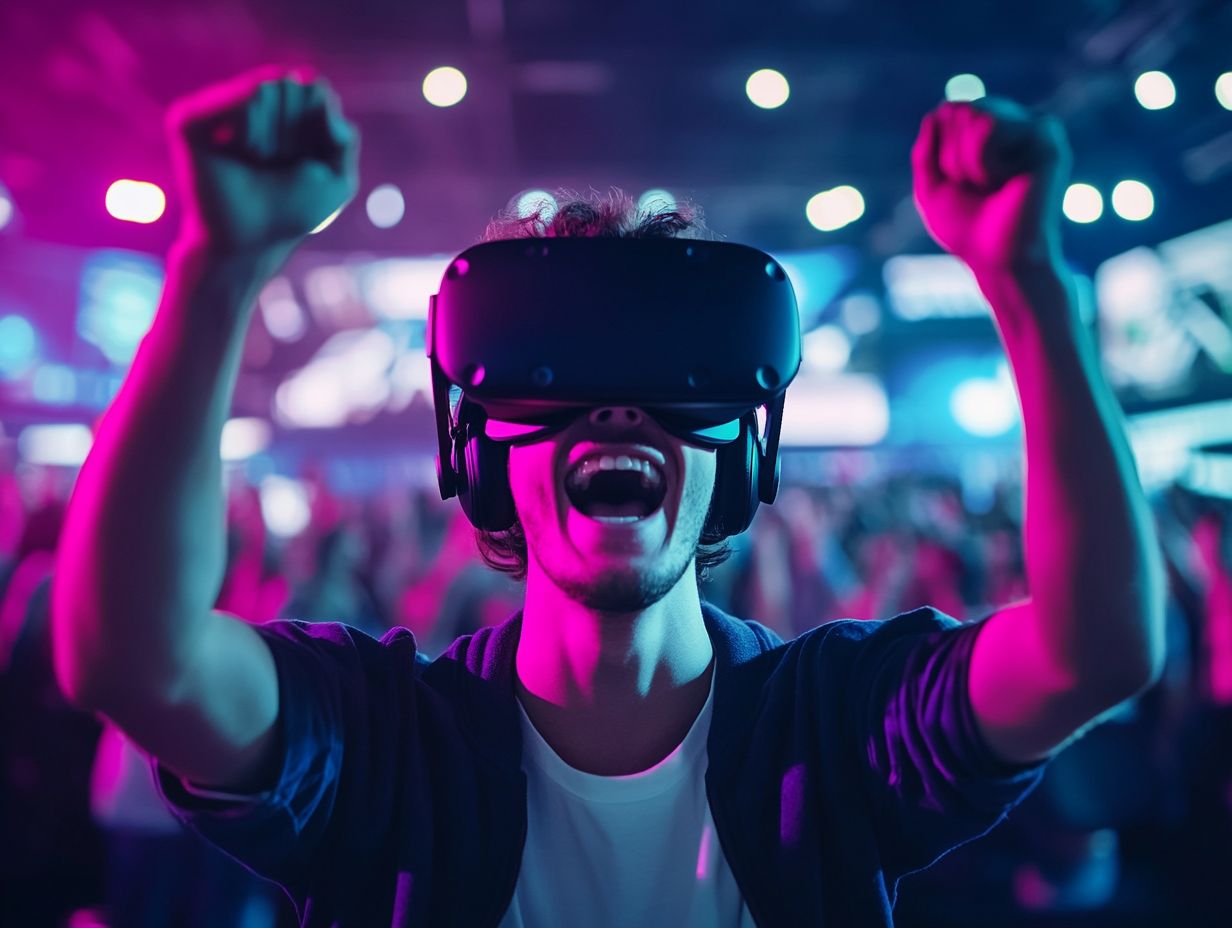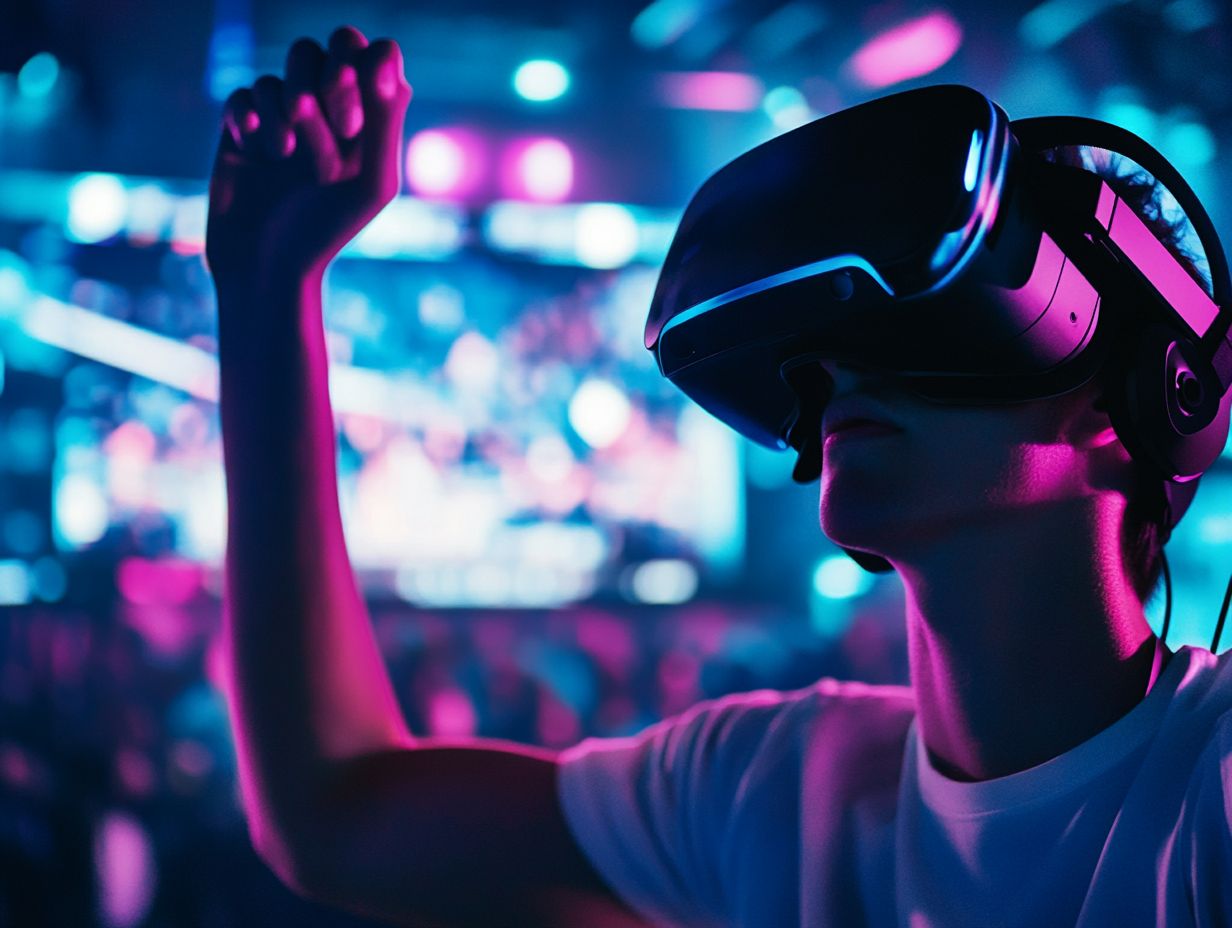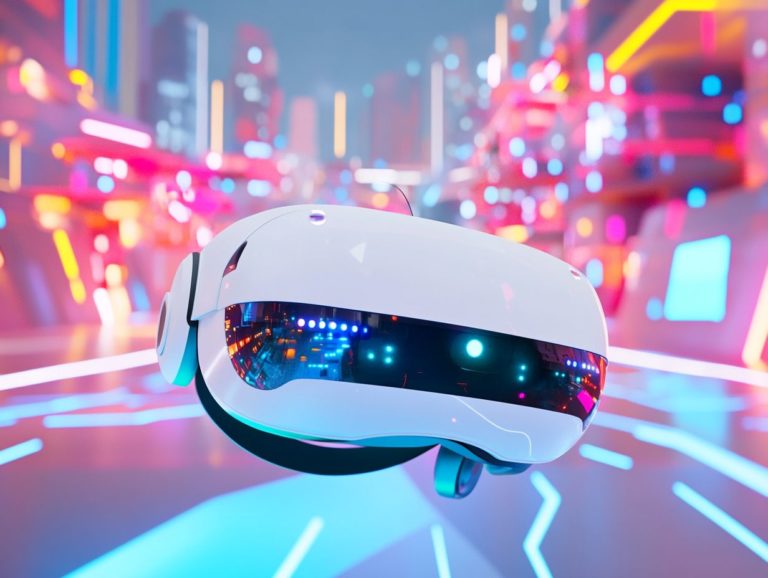the role of vr in e-sports: a new frontier
Virtual reality (VR) is transforming the e-sports landscape, presenting players and fans with an unprecedented experience. With its remarkable ability to enhance immersion and realism, VR is emerging as an essential tool for elevating training and performance.
You ll delve into its potential impact and the challenges it encounters. Explore practical strategies for seamlessly integrating this technology into tournaments and events.
Embark on this journey to uncover what the future holds in this exhilarating frontier.
Contents
Key Takeaways:

Virtual Reality (VR) offers enhanced immersion and realism in e-sports, providing a more engaging experience for players and spectators alike. This technology has the potential to improve training and performance in e-sports, offering players realistic simulations of game scenarios. Despite challenges, the future is brimming with possibilities for this new frontier in gaming.
Defining Virtual Reality and E-sports
Virtual Reality (VR) and E-sports are at the forefront of gaming innovation, creating experiences that captivate players in new ways. As VR technology advances, exciting opportunities arise, connecting you with a vibrant community through interactive entertainment.
The intuitive engagement of VR headsets and the thrilling competition of E-sports are transforming the gaming industry. The lines between virtual and real-world interactions blur, paving the way for a growing VR market.
Major players like Meta Platforms and Oculus are leading the charge in hardware and software advancements, making VR more accessible. Companies like HTC and Sony are also essential, driving innovation through their unique platforms.
Titles like Beat Saber and Half-Life: Alyx exemplify the captivating potential of VR gaming, attracting both casual gamers and serious e-sports aficionados. Collectively, these elements are sculpting a future where participation and viewing experiences in gaming are set to revolutionize interactions for players and electrify excitement for spectators.
The Benefits of VR in E-sports
The integration of Virtual Reality into E-sports offers a wealth of benefits that transform your gaming experience. With VR technology, you can immerse yourself in the game, feeling as though you are genuinely part of the action.
This heightened engagement deepens your understanding of gameplay mechanics, spatial awareness, and team dynamics. As developers leverage the capabilities of VR headsets, they are crafting realistic experiences that redefine competitive gaming.
These advancements position E-sports to attract new audiences and broaden its influence within the larger gaming industry.
Enhanced Immersion and Realism
Enhanced immersion and realism in VR have revolutionized your experience of E-sports. With sophisticated VR technology, you interact with virtual worlds in ways that once seemed unimaginable.
This heightened sense of presence captivates you and sharpens your ability to strategize and respond to in-game events in real-time. As you don your VR headset, you find yourself fully immersed in gameplay, where your movements translate seamlessly into the virtual space.
Leading VR titles like Beat Saber and Echo Arena exemplify these advancements, showcasing how you navigate dynamic environments with unmatched fluidity. The technology is evolving, promising richer interactions and deeper storytelling.
This evolution raises the bar for both players and developers, encouraging the industry to explore innovative ways to blend skill and entertainment in a 360-degree realm.
Improved Training and Performance

Utilizing Virtual Reality (VR) for training can significantly enhance your performance. It offers innovative ways to practice and refine your skills in E-sports.
With the ability to simulate intricate scenarios and environments, VR turns your training into a realistic playground. You can sharpen your reflexes, strategies, and teamwork all without the limitations of traditional gaming setups.
This groundbreaking approach elevates your individual gameplay and uplifts the entire competitive landscape of the gaming industry.
For example, you can engage in virtual scrimmages that mirror high-pressure matches. This helps you get used to high-pressure situations and improve your decision-making skills.
Developers play a crucial role in creating these tailored experiences. They use analytics to monitor your performance and adapt training modules to suit your needs.
As this trend continues to grow in E-sports, it opens up more engaging training techniques. This nurtures a new generation of elite players who are better equipped to tackle the challenges of competitive gaming.
The Future of VR in E-sports
The future of VR in E-sports is incredibly exciting! The gaming industry is embracing innovative solutions that promise to transform competitive play.
As VR technology evolves rapidly, expect a surge in community connection and engagement through engaging experiences that attract a wider audience.
The expanding VR market, combined with advancements in AI technology, is set to create new opportunities for both players and developers. This will further integrate VR into the very fabric of E-sports.
Potential Impact and Growth
The impact of VR on the E-sports landscape is revolutionary. With projected growth patterns indicating an expanding market, the excitement is building.
As this technology becomes more accessible and affordable, many new participants will flock to engaging experiences, eager to dive in.
This growth enhances community connection and paves the way for more captivating content, showcasing the incredible capabilities of VR technology in competitive gaming.
Recent statistics suggest that the VR gaming market is on track to surpass $12 billion by 2024. This creates a golden opportunity for E-sports to attract a diverse audience.
As a developer, you can innovate by crafting games that leverage virtual reality while encouraging both collaborative and competitive play. This enriches player interactions.
As players immerse themselves in a broader, more interactive community, the social dimensions of gaming will thrive. This transformation could redefine player engagement and reshape the future of E-sports in ways we are only just beginning to imagine.
Challenges and Limitations of VR in E-sports
While integrating VR into E-sports presents thrilling possibilities, there are challenges and limitations to navigate for full potential.
Hardware constraints and financial barriers often hinder both players and developers. This creates a gap in access and participation within the gaming community.
The industry must tackle these challenges to make VR accessible to everyone in the competitive gaming arena.
Technical and Financial Barriers

Technical and financial barriers present significant challenges for the widespread adoption of VR technology in E-sports. These barriers often limit accessibility for both players and developers. High costs for advanced VR headsets may discourage potential users. Additionally, complex integration adds to this challenge.
Addressing these issues is crucial for the growth and sustainability of VR within competitive gaming. These barriers create a divide in the gaming community, as many aspiring players lack the resources to invest in premium technology.
Developers need to invest in VR, but the returns may not be immediate, which stifles innovation. This situation highlights the urgent need for more affordable solutions that can democratize access to VR gaming.
By fostering an environment where technology is both accessible and economically viable, the industry could unlock new avenues for participation. This paves the way for transformative experiences that elevate competitive gaming to new heights.
How to Incorporate VR in E-sports
Incorporating Virtual Reality into E-sports requires careful planning and execution. The goal is to create immersive and captivating tournament experiences.
By harnessing innovative VR technology, you can enhance player participation and spectator engagement. This leads to unforgettable events that showcase the potential of next-gen gaming.
This seamless integration amplifies the thrill of E-sports tournaments and sets a benchmark for future advancements in interactive entertainment.
Implementing VR Technology in Tournaments and Events
Implementing VR technology in E-sports tournaments and events can heighten the experience for both players and spectators. By embracing VR headsets and immersive environments, you can engage in competitions that feel uniquely interactive.
This approach fosters deeper community engagement and attracts new audiences who are captivated by cutting-edge gaming.
To effectively integrate VR, first navigate logistical challenges. Ensure there is enough space for setup and that high-speed internet connections are available. It’s crucial to train staff on operating VR equipment and to design a user-friendly interface for participants.
Engagement strategies could include:
- Live-streaming VR competitions
- Offering virtual meet-and-greets with players
- Gamifying the spectator experience with interactive features that allow fans to influence gameplay
The potential benefits are substantial. You can expect heightened emotional investment from viewers and a memorable, immersive atmosphere that distinguishes these events in the bustling entertainment landscape.
Frequently Asked Questions
What is the role of VR in E-sports?

The role of VR in E-sports is to provide a more immersive and realistic experience for players and viewers alike. With VR technology, players can feel as if they are truly in the game, enhancing their performance and enjoyment.
How does VR improve the e-sports experience?
VR improves the e-sports experience by allowing players to physically interact with the game rather than just using a controller or keyboard. This adds a new level of skill and strategy to the game, making it more exciting for both players and viewers.
What are some popular VR e-sports games currently?
Some popular VR e-sports games include Beat Saber, Echo Arena, and Onward. These games offer various competitive gameplay styles, from music rhythm to first-person shooter, making them appealing to a wide audience.
What impact does VR have on the future of e-sports?
VR has the potential to revolutionize the e-sports industry by creating a more immersive and engaging experience for players and viewers. It also opens opportunities for new games and challenges, attracting a broader audience to the world of E-sports.
How Does VR Affect the Training and Skills of E-Sports Players?
VR allows e-sports players to train in a realistic and challenging environment. It improves how well players use their hands and eyes together and reaction time, giving them an edge in competitive tournaments.
Are There Any Downsides to Using VR in E-Sports?
While VR has many benefits, there are downsides to consider. The cost of equipment can be a barrier, and not all games may be accessible without VR technology.
There are also concerns about motion sickness and the learning curve associated with using VR in competitive gaming. Players need to adapt to this technology to fully benefit from it.





